Northwest Missouri State University
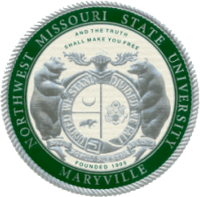 | |
Former names |
Fifth District Normal School Northwest Missouri State Teacher's College Northwest Missouri State College |
|---|---|
| Type | Public |
| Established | 1905 |
| Endowment | $25.5 million (2015)[1] |
| President | John Jasinski |
| Provost | Timothy Mottet |
Academic staff | 253 |
| Students | 6,485 (Fall 2014)[2] |
| Undergraduates | 5,542 (Fall 2014)[2] |
| Postgraduates | 943 (Fall 2014)[2] |
| Location |
Maryville, Missouri, U.S. 40°21′12″N 94°53′00″W / 40.353306°N 94.88340°WCoordinates: 40°21′12″N 94°53′00″W / 40.353306°N 94.88340°W |
| Campus | Rural, 370 acres (149.7 ha) |
| Colors |
Bearcat green and White |
| Nickname | Bearcats |
| Mascot | Bobby the Bearcat |
Sporting affiliations | NCAA Division II – MIAA |
| Website |
www |
 | |
Northwest Missouri State University is a state university in Maryville, Missouri, United States. Founded in 1905 as a teachers college, it offers both undergraduate and graduate programs. The campus, based on the design for Forest Park at the 1904 St. Louis World's Fair, is the official Missouri State Arboretum.[3] The school is governed by a state-appointed Board of Regents and headed by President Dr. John Jasinski.
The Northwest Bearcats compete in the National Collegiate Athletic Association (Division II) and Mid-America Intercollegiate Athletics Association for men's and women's sports. They have won five NCAA Division II football national championships (1998, 1999, 2009, 2013 and 2015) and finished four times as runner-up (2005, 2006, 2007, and 2008).[4] The Northwest Bearcats cheerleading squad have won three (2010, 2012, and 2013) Universal Cheerleaders Association Division II National Champions.[5]
History
Founding
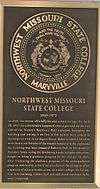
In 1905 the Missouri Legislature created five districts in the state to establish normal schools, comprising a state teacher college network.
Maryville won the competition for the Northwest district with an offer to donate 86 acres (34.8 ha) (on coincidentally the northwest corner of town) and $58,000 on the site of a Methodist Seminary. The other districts in the network were to be at Kirksville (Northeast - now Truman State), Cape Girardeau (Southeast), Springfield (Southwest - now Missouri State), and Warrensburg (Central - now Central Missouri).
The original mission of the school, initially known as the Fifth District Normal School, was to teach elementary school teachers. Classes began on June 13, 1906 with a lab school teaching Maryville's children (that was eventually named the Horace Mann school) in kindergarten through third grade. The school was later expanded to a full-fledged high school before dropping back to its current configuration of kindergarten through sixth grade.

In 1919 the school was renamed Northwest Missouri State Teacher's College, and with that the ability to grant baccalaureate degrees. In 1949 the name was shrunk to Northwest Missouri State College by the Board of Regents.
World War II
During World War II, Northwest Missouri State University was one of 131 colleges and universities nationally that took part in the V-12 Navy College Training Program which offered students a path to a Navy commission.[6]
Rivalry with Missouri Western
In 1969, Missouri Governor Warren Hearnes pushed for switching St. Joseph Junior College from a two-year school into a four-year state college. At approximately the same time, authorities decided against a plan to continue routing Interstate 29 north of St. Joseph along U.S. Route 71 through Maryville and Clarinda, Iowa, instead picking a route to Council Bluffs, Iowa/Omaha, Nebraska along the sparsely populated Missouri River bottoms.
Opening a new four-year state school within 45 miles (72 km) of Maryville (along with a delay in widening U.S. Route 71 to Maryville) was perceived in Maryville as an attempt to kill the school and the town with which it is intertwined. Those fears came to the forefront in 1988 when Shalia Aery, commissioner of higher education under Governor John Ashcroft, announced a plan to close the school.[7] The plan was ultimately withdrawn.
Northwest Missouri State University
On August 14, 1972, Northwest was elevated to university status so that it could offer master's degrees. Its name changed to Northwest Missouri State University.
The university currently holds four Missouri Quality Awards, granted in 1997, 2001, 2005, and 2008. Northwest is the only educational institution to receive multiple Missouri Quality Awards.[8]

In 1987, Northwest unveiled its Electronic Campus Program, the first such program among public U.S. colleges.[9]
Missouri State Arboretum

The campus design was inspired by the Forest Park design for the 1904 St. Louis World's Fair which evolved into the campus for Washington University. In 1993 the state legislature designated Northwest the official Missouri State Arboretum.
Administration building
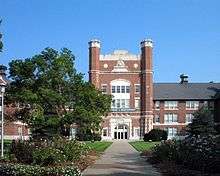
Design
The defining landmark of the campus is the Administration Building, very similar to Brookings Hall at Washington University in St. Louis. Brookings Hall served as the Administration Building of the 1904 St. Louis World's Fair. The master St. Louis design was created by Cope & Stewardson, famed for designing schools throughout the country based on the Oxford University style.
The Collegiate Gothic structure with its central tower keep design evokes Tattershall Castle and lords over the campus with the motto, "And the truth shall make you free," engraved in stone. Because of this design, the term "Tower" is used frequently throughout campus and is the name of the school yearbook. Work on the building began in 1906 and continued on and off until classes began in it on October 3, 1910. The architect of record for the Maryville building is John H. Felt. On March 15, 1919, a tornado ripped the roof off its auditorium and blew out most of its windows.
1979 fire
On July 24, 1979, a fire destroyed 60 percent of the building on the central and west wing as well as the north wing housing the auditorium and Little Theater. Many thought the building was going to be razed, However the east wing survived with relatively little damage.
A $13.8 million capital program repaired most of the building and made extensive changes to the campus layout. The building ceased to serve as classroom space, with the exception of 3rd floor, which houses the Family and Consumer Sciences Department. The theater and music departments moved out of the building to what is now the Ron Houston Center for the Performing Arts, located southeast of Bearcat Stadium. The north wing of the Administration Building was torn down and sealed, although the outline of the wing is still visible against the bricks on the north. The former Wells Library (now Wells Hall) was turned into a classroom area and home for the National Public Radio affiliate radio station KXCV-FM and the library was moved to its current location in the new B.D. Owens Library. All the academic files were burned and lost with no backups prior to the fire.
Athletics

Northwest was a founding member of the Mid-America Intercollegiate Athletics Association in 1912 and has remained in the conference ever since. From its founding until 1937 it competed in the Amateur Athletic Union. From 1937 to 1957 it competed in the National Association of Intercollegiate Athletics. In 1957 it joined NCAA Division II. Northwest has appeared in nine Division II football title games (winning five) since 1998. The men's basketball team appeared in an AAU title game in 1930.
Student organizations
Student organizations encompass activities and interests that include Academic (such as an Association for Computing Machinery chapter),[10] Greek fraternities and sororities, Political (such as the College Republicans or the Young Democrats),[11] Honorary (such as the Blue Key Honor Society and Mortar Board),[12] Multicultural (with groups such as the Alliance of Black Collegians, the Asian Student Association, the Hispanic American Leadership Organization, and the Indian Student Association),[13] Performing (such as the American Choral Directors Association),[14] Religious (such as Campus Crusade for Christ),[15] Residential Life (with student governing bodies for the residential halls),[16] Sports (with clubs for cheerleading, fencing, rugby, soccer, wrestling and equestrian sports),[17] and dozens more.[18]
Fraternities at the university include Alpha Gamma Rho, Alpha Kappa Lambda, Alpha Phi Alpha, Delta Sigma Phi, Kappa Kappa Psi, Phi Delta Theta, Phi Mu Alpha, Phi Sigma Kappa, Sigma Alpha Iota, Sigma Phi Epsilon and Sigma Tau Gamma.[19] Sororities include Alpha Delta Pi, Alpha Sigma Alpha, Delta Sigma Theta, Phi Mu, Sigma Alpha, Sigma Kappa, Sigma Sigma Sigma and Zeta Phi Beta.[19]
Campus lore
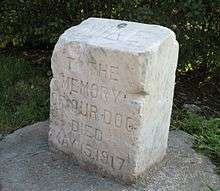



- Mike the Dog - Although the team mascot is a bearcat, perhaps the school's most touching monument is a small memorial to a dog near the east end of the Administration Building. Mike (which appears to resemble a Cairn Terrier) was a campus fixture from 1916–1917 and wore a green blanket with an "M" on it. Mike died after drinking arsenide of lead mistaking it for water. Students raised money for the memorial.
- Roberta Hall ghost - On April 28, 1951 a gas tanker car stored on a siding of the Wabash Railroad tracks behind what was then Residence Hall exploded, sending steel chunks several blocks away. The ensuing fire destroyed much of Residence Hall and injured Roberta Steel, who was about to die from the wounds in 1952. The Hall was rebuilt and renamed for Roberta. A persistent story says that she haunts the building throwing hair brushes.
- Bobby the Bearcat - Northwest initially did not have a formal mascot and had been nicknamed the "Normals." In 1916 a Drury College coach asked the Northwest coach if his bearcats were ready to play. The name stuck.
- Northwest Yeti - Although the official mascot is Bobby the Bearcat, a Yeti can often be seen at Northwest events, including basketball and football games. The Yeti has a small cult following.
- Kissing Bridge - The small wooden kissing bridge was over a small usually dry creek leading to Colden Pond southwest of Charles J. Colden Hall. Legend says that a female student isn’t officially a co-ed until she has been kissed on the bridge before the first snowfall. Another legend says that if you cross the bridge you will visit the campus again. The bridge has been moved from its original location closer to Colden Hall.
- University Seal in the Bell Tower - The university seal, which is also the seal of the State of Missouri, is at the base of the Bell Tower. According to legend, if you walk across it you risk flunking. In a 2004 restoration of the tower the seal was moved to a display case.
- Bell of 48 - A gift from the class of 1948, the bell is rung to announce athletic victories, in memory of any member of the University community and to announce other events deemed important by Student Senate and the administration. The bell is rung at 8:00 AM, (the time classes usually start,) on the Friday before the homecoming game, in order to signify Walk-Out Day. The seniors used to ring the bell some time in the day to "release" the other students from classes. Each year it became earlier until the University made it a tradition by cancelling classes that day.
- Hickory Stick - The hickory stick is given to the winner of the Northwest and Truman State University (Kirksville, MO) football game. The hickory stick says, "This Hickory Stick was grown on a farm in the Maryville District on which Eugene Fair, President of Northeast Missouri State was born." The first recorded game score is from 1908. Also noted on the stick is 1942, '43, '44 and '45 "WAR NO GAME." By tradition the winning team repaints the metal tip with their school color. Truman holds the overall advantage 42-28-4; however, Northwest has owned the hickory stick for the last 8 years, including a 49-0 victory in 2008 as well as a 70-0 win in 2009.
- World's Shortest St. Patrick's Parade - Starting off as a joke for downtown watering hole The Palms, it is an ever-diminishing tradition of having of the world's shortest Saint Patrick's Day Parade. Originally going a block on Buchanan from Fourth Street to Fifth Street, the parade has gotten shorter and shorter each year to maintain the record. It was 86 feet (26 m) in 2006.
- Laptop Program - Northwest gives HP laptop computers to all students for use during the school year.
Presidents
- Frank Deerwester (1906–1907)
- Homer Martien Cook (1907–1909)
- Henry Kirby Taylor (1909–1913)
- Ira Richardson (1913–1921)
- Uel W. Lamkin (1921–1945)
- J.W. Jones (1945–1964)
- Robert P. Foster (1964–1977)
- B.D. Owens (1977–1984)
- Dean L. Hubbard (1984–2009)
- John Jasinski (2009–Present)
Notable alumni
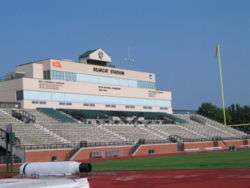

Among Northwest's alumni are Jean Bartik, one of the original programmers for the ENIAC computer and a member of the Women in Technology International Hall of Fame.
Politicians include:
- Jason R. Brown - a Republican leader in the Missouri House of Representatives
- Pat Danner - a former U.S. representative from Missouri
- Steve King - U.S. representative from Iowa's 4th congressional district.
- Leonard Lenihan - a Democratic leader in New York
- Bill Siebert - former member of the Texas House of Representatives from San Antonio[20]
- Mike Thomson, Republican member of the Missouri House of Representatives
Professional athletes and sports figures include:
- Jack McCracken, an AAU basketball player from the 1930s and 1940s who in 1962 was enshrined into the Basketball Hall of Fame.[21]
- Gary Gaetti - Major league baseball player
- Chris Greisen - a former quarterback
- Tony Miles - Canadian Football League wide receiver; school's all-time leader in receptions, receiving yards and receiving touchdowns
- Xavier Omon - National Football League (NFL) running back and 2008 6th round draft pick of the Buffalo Bills
- Jamaica Rector - NFL wide receiver for the Arizona Cardinals
- Mike Shane - professional wrestler
- Todd Shane - professional wrestler
- Mel Tjeerdsma - Northwest's national champion winning coach, and most winning DII post-season coach with 22 victories.
- Dave Tollefson - a former defensive end
- Seth Wand - a former offensive lineman
- Brandon Dixon - NFL cornerback for the Tampa Bay Buccaneers, drafted in the 6th round of the 2014 Draft by the New York Jets.
- Brian Dixon - NFL cornerback for the New Orleans Saints, signed as an undrafted free agent in 2014.
- Tom Pestock - WWE professional wrestler, 2016 Andre the Giant Memorial Battle Royal winner.
See also
- Northwest Missourian – Student newspaper
References
- ↑ As of June 30, 2015. "U.S. and Canadian Institutions Listed by Fiscal Year (FY) 2015 Endowment Market Value and Change in Endowment Market Value from FY 2014 to FY 2015" (PDF). National Association of College and University Business Officers and Commonfund Institute. 2016.
- 1 2 3 "Higher Learning Commission". ncahlc.org.
- ↑ Northwest Missouri State University. "Missouri Arboretum". nwmissouri.edu.
- ↑ "National Champions". D2football.com. Retrieved 2010-03-16.
- ↑ "Northwest cheerleading wins 2nd national title in three years". St. Joseph Post newspaper website. 2012-01-16. Retrieved 2012-01-30.
- ↑ "Men and Women of the Greatest Generation" (PDF). Navyleague Councils Support. 2011. Retrieved September 29, 2011.
- ↑ "ST. Louis Post-Dispatch Newspaper Archives". newsbank.com.
- ↑ Northwest Missouri State University. "About Us". Nwmissouri.edu. Retrieved 2010-03-16.
- ↑ "Rediscovering WWII's female 'computers'". CNN. February 8, 2011. Retrieved 2011-02-09.
Back in Missouri, Bartik's alma mater became the first public U.S. college to install computer terminals, telephones and cable TV in every dorm room. By the late 1980s, more than 6,000 students there were communicating by e-mail and reading stories from the student newspaper on computer screens.
- ↑ "Academic and Departmental Organizations". Northwest Missouri State University. Retrieved 2011-02-09.
- ↑ "Government and Political Organizations". Northwest Missouri State University. Retrieved 2011-02-09.
- ↑ "Honorary Organizations". Northwest Missouri State University. Retrieved 2011-02-09.
- ↑ "Academic and Departmental Organizations". Northwest Missouri State University. Retrieved 2011-02-09.
- ↑ "Performing Organizations". Northwest Missouri State University. Retrieved 2011-02-09.
- ↑ "Religious Organizations". Northwest Missouri State University. Retrieved 2011-02-09.
- ↑ "Residential Life Organizations". Northwest Missouri State University. Retrieved 2011-02-09.
- ↑ "Sport Clubs". Northwest Missouri State University. Retrieved 2011-02-09.
- ↑ "Special Interest Organizations". Northwest Missouri State University. Retrieved 2011-02-09.
- 1 2 "Greek Organizations". Northwest Missouri State University. Retrieved 2011-02-09.
- ↑ "Bill Siebert". talhi.com. Retrieved September 24, 2011.
- ↑ "Jack D. McCracken". Basketball Hall of Fame. Retrieved 2011-02-09.
External links
| Wikimedia Commons has media related to NWMSU. |
- Official website
- Northwest Missouri State Athletics website
- Northwest Missouri State University at National Center for Education Statistics: College Navigator
_logo.svg.png)